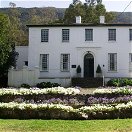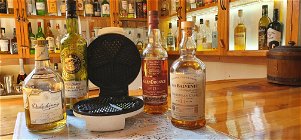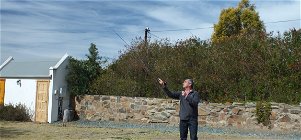Arts & Culture in Somerset East, KwaNojoli
Walter Battiss Art Museum
The Walter Battiss Art Museum building was in use during the time of Somerset Farm (before the town of Somerset East was established in 1825) and was used as an Officers Mess for British troops stationed on the eastern Frontier. Note the beautiful fanlight and the railings in the picture alongside. The cast-iron fence was transported by wagon from Cape Town. Yellowwood from the Boschberg Mountain provided wood and beams for some partitions of the first floor. Several fireplaces still in the building, have the royal coat of arms built into them. The Victorian veranda was added later.
Walter Wahl Battiss was born in Somerset East in 1906. At one stage the family rented 45 Paulet Street, and ran it as the Battiss Private Hotel.
The Walter Battiss Art Museum was officially opened on 24 October 1981. Battiss was present on the day, and donated 65 of his private collection of artworks to “the people of Somerset East”. He died in 1982.
After extensive deterioration, the gallery was closed to the public at the end of 1999, and reopened on 5 November 2004, after restoration.
Today it houses a permanent exhibition on the works of Battiss, including water colours, oils, rock art and Fook Island.
The Museum is open from 10 am to 2 pm on weekdays, and on weekends or Public Holidays by appointment. Various prints and other items are on sale at the Museum. Entrance fees, donations and sales are managed by the Walter Battiss Foundation, a not for profit organisation started to preserve this gem for future generations to enjoy.
KwaNojoli Museum
Shortly after the establishment of the village of Somerset in 1825, a plot at the foot of the Boschberg was granted to the Wesleyan Church for the erection of a Chapel and to serve as a “burying” ground, the oldest in town. The Chapel was opened in 1828. A few years later, the property was transferred to the Dutch Reformed Church and by 1835, the building had been converted into a Parsonage (Pastorie).
During the 105 years that the building was used as a Parsonage, it was occupied by the Morgan, Pears and Hofmeyer families. Five generations of Hofmeyrs occupied the Parsonage for some 88 years.
It was declared a Province-aided Museum and a National Monument in 1972, and the Museum was officially opened in 1975 after restoration.
Situated in picturesque surroundings, the Georgian Museum building is a special place to visit. Plans are underway to erect additional buildings on the ground, as well as to restore the current buildings. The museum may be closed during this time.
The graveyard is home to the gravesite of Ouma Dora Jacobs, died in 2003 at age 122, then the oldest person in the world.
The permanent exhibition on the 1815 Slagter’s Nek Rebellion opened in 2006, and offers insight into events which happened around the world in the same era. There are several other exhibitions in the museum, depicting an inclusive historical account.
It is advisable to call ahead if you would like to visit the museum; 042 243 2079







Share This Page